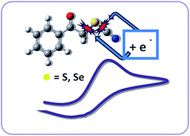Publication
765
RCS Adv., 5 (16), 11753-11760, 2015
DOI:10.1039/C4RA16154H
|
|
|
|
|
|
 |
Breaking bonds with electrons: stepwise and concerted reductive cleavage of C-S, C-Se and Se-CN bonds in phenacylthiocyanates and phenacylselenocyanates |
|
|
|
Lydia M. Bouchet, Alicia B. Peñéñory, Marc Robert, and Juan E. Argüello
INFIQC-CONICET-UNC, Dpto. de Química Orgánica, Facultad de Ciencias Químicas, Universidad Nacional de Córdoba, Ciudad Universitaria, X5000HUA Córdoba, Argentina
Université Paris Diderot, Sorbonne Paris Cité, Laboratoire d’Electrochimie Moléculaire, Unité Mixte de Recherche Université−CNRS no. 7591, Bâtiment Lavoisier, 15 rue Jean de Baïf, 75205 Paris Cedex 13, France
The mechanistic aspects of the electrochemical reduction of phenacylthio- and selenocyanates have been studied. With phenacylthiocyanates (1), a change in the reductive cleavage mechanism is observed as a function of the substituent on the phenyl ring. While a stepwise mechanism involving the intermediacy of a radical anion is followed for substrates bearing a strong electron withdrawing group, such as cyano and nitro substituent (1d, 1e), and a concerted mechanism is favoured for compounds bearing an electron-donating or no substituent on the phenyl ring (1a–c). A regioselective bond cleavage leads to the fragmentation of the CH2–S bond with all compounds 1a–e, further yielding the corresponding 1,4-diketone (3) as products. Contrastingly, with phenacylselenocyanates (2), two different reductive cleavages occur involving the breaking of both the CH2–Se and Se–CN bonds. Several products are obtained, all coming from nucleophilic attack at the a (phenacyl) carbon or the selenium atom. |

